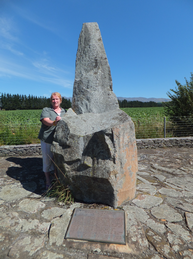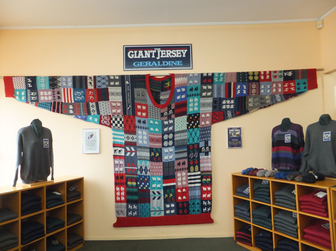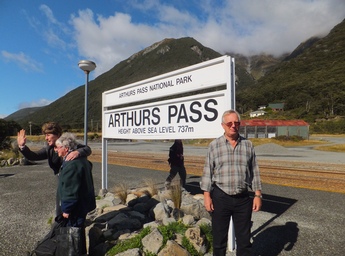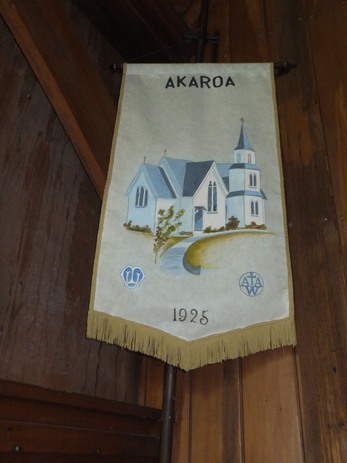



The Parish Church of St George the Martyr, Waterlooville

Our goal was not far away -
We continued down the gorge to the coast, passing sheep “safely grazing” and headed to Geraldine for a couple of nights. In honour of the day we drank a bottle of Rabbit Island white wine that night.
Our quest in Geraldine was the World’s Biggest Jumper! A shop selling expensive knitwear displays this award winning item, knitted to show the range of patterns available on the knitting machines. As a side line, the owner has created a complete mosaic of the Bayeux Tapestry using all the tiny cogs from the redundant pattern wheels used in knitting machines. A work of art that has been extended to depict some missing parts of the story, the gentleman is now working on a similar project to create the story of the Battle at Stamford Bridge, fought before the Battle of Hastings. Our other memory of Geraldine was the discovery of a slow puncture and the need for a “Kwickfit” to keep us on the road. Having solved that problem we were able to visit Timaru (much of which was closed on a Saturday afternoon) and Caroline Bay – a beautiful stretch of sandy beach.
The next day we set off north to Christchurch (as previously described) and our date with the Tranzalpine Railway. We were picked up by taxi at an uncomfortably early hour to go to the station for a day trip across South Island to Greymouth via Arthur’s Pass. The weather was a little gloomy but had the promise of improvement as we chugged out of Christchurch and across the plain, heading towards the mountains and along the Wimakariri River. After a brief stop at Sheffield we continued over amazing bridges and through tunnels to Arthur’s Pass, 737m above sea level. Here the energetic disembarked to make the most of the walking opportunities and spectacular views in the National Park. The rest of us continued on past the parked up engines used to pull the heavy coal trains up from the west coast and through the Otira Tunnel. Built by a huge team of construction workers who lived in Otira village (now mainly a holiday home village) or camped at Arthur’s Pass, the tunnel is 5 miles long. It took 10 years for the two ends to meet, and another five years before the first train travelled through it in 1923. The descent to Greymouth was a little damp and grey and the lakes and rivers didn’t really have a chance to show themselves off.
The train pulled in to Greymouth and was met by several coaches ready to take passengers onward on trips to the glaciers etc. We made a dash for Speight’s Ale House for a second helping of the delicious whitebait patties. We even had time to browse the shops and buy a few last minute souvenirs before catching the train for the return journey. As we climbed away from the sea the sun came out and we headed for the front observation platform to enjoy the scenery. It was great fun and we enjoyed the trip much more in this direction. We arrived back in Christchurch smelling of diesel after going through the smaller tunnels (we retreated to the carriage, as advised, for the long one!).
The following day we drove out to Akaroa, east of Christchurch, on the Banks Peninsula. We had been so saddened by the damage in Christchurch we couldn’t bear to revisit. Akaroa is a little bit of France, founded by whalers in 1840. In the time it took for the French to organise themselves to form a trading company as a vehicle for colonising, Britain had signed the Treaty of Waitangi. British sovereignty was quickly established but the first French settlers stayed. Today the tricolour flies and the town boasts a boucherie and a petanque piste. The cafés and restaurants provide a chance for French youngsters to work in their gap years so that the French accent can be heard around town. I found St Peter’s Church which displays an attractive MU banner. The harbour is beautiful – a flooded volcano providing shelter and chances of seeing dolphins, penguins and seals on the regular boat trips. We felt the first touches of autumn now – Colin wore his jeans!! – and so it was back to the camp site to pack up our camper van home of the last 6 weeks, ready for our onward trip to Australia to see Colin’s relatives. Needless to say, the savings account has been started for the return trip – places we haven’t seen and favourites to revisit on the itinerary.
Rosemary Monk
Easter Edition 2013
Travels in New Zealand
After a couple of damp days, the sun finally came out and showed us Lake Tekapo at its best and the beauty of the Church of the Good Shepherd (as described in a previous issue). That night there was a full moon that reflected beautifully in the lake and attracted a crowd of campers to admire it. There was a good atmosphere as we swapped stories of our travels and beers.
We set off back to the coast, stopping in Fairlie for coffee. The town has an avenue (Peace Avenue) planted on either side with trees to mark the end of World War I and as a memorial to the soldiers who died. There is also a statue of James Mackenzie and his dog. Although he was a sheep rustler, it was his use of the inland pastures for his stolen flocks that proved that New Zealand could become a major sheep producing country.
At this point we were on a mission to find a piece of family history. We headed off in the direction of the Pareora Gorge and a village called Cave. On the way we were held up in a “traffic jam” – a most unusual occurrence. Even more unusual was the presence of armed police. At first we thought that the incident they quoted was perhaps a careless driver being pulled out of a ditch or an escaped flock of sheep. When we were finally allowed to continue we came across a large number of heavily armed police packing up and heading home. We never did find out what had actually happened in such a quiet country backwater.

The Memorial at Motakaika


